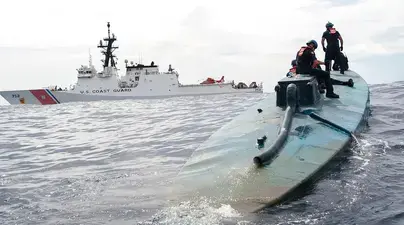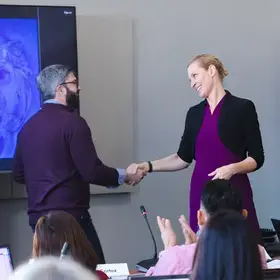By Nick Schiff
The Joint Chiefs of Staff occupies an office deep in the Pentagon. On one wall hangs a photograph of five men in orange vests on top of a semi-submersible just at the ocean's surface. Like the other photographs in the room, the image represents one branch of the United States military, in this case, the Coast Guard. It was taken by LaNola Stone.
The men in orange vests are seizing $180 million of cocaine, which they found hidden in the small narco-submarine while patrolling the Eastern Pacific. That day, LaNola was embedded with them on their mission and captured the moment with her camera lens.
Stone is now a student in the Executive Master of Strategic Communication program at Columbia. Her goal is to tie together her resume to position herself for a role in corporate communications.
Below, she explains her career path and her plan going forward.

Crew from the U.S. Coast Guard Cutter Stratton stop a Self-Propelled Semi-Submersible (SPSS) off the coast of Central America. U.S. Coast Guard picture by Petty Officer 2nd Class LaNola Stone.
How do you describe what you do?
I’m a communicator who solves problems for my clients creatively. When I look at my heroes, they were never boxed into one style but had steady situational awareness and could adapt. Like them, I suppose, my career has neither been linear nor standardized.
Can you give me a sense of your career path?
When I was 24, I moved from Utah to New York City and my first job was as a photo assistant. I garnered a reputation for the quality of my work. One of my former clients was an investor who was looking for a creative director of a magazine she provided seed money for; I submitted my creative vision and was offered the job. Suddenly, the tables had turned: I used to submit my portfolio for shooting gigs, and I was now the one awarding creative contracts to photographers. After a year in that position, I moved on to the School of Visual Arts to refine my commercial and fine art acumen. I won several awards and my work was selected for Art Basel Miami. Not long afterward I was approached by Focal Press, to write a book—which I did.
How did you come to join the Coast Guard?
The idea first came to me when writing about one of my one of my photographic heroes, Edward Steichen. He used his talent in service to his country during the First World War as part of the Naval Aviation Photographic Unit. He Inspired me with his service and devotion to duty.
I joined the Coast Guard as a public affairs specialist, doing everything from documenting missions with photo and video to writing press releases, liaising with the media, and writing and distributing internal communication action plans.
You have a prestigious portfolio and a master’s from SVA. Why are you pursuing another master’s at Columbia?
A Strategic Communications degree from Columbia will tie together all my communication experience: visual, planning, consulting, and writing, which will enable me to market myself effectively to employers.
The degree will also give me the negotiating power to achieve my other career goals. I want to shift to corporate communications work and leave freelance and the military behind, to find a position that is both fulfilling and flexible, so I can spend more time with my son.
On top of that, the GI Bill is mostly sponsoring my time here, which made the decision easy.
What skills are you gaining here?
In my "Industry Insider" class, we learn how companies really operate. Every Thursday we visit a different organization, or they come to us as guest lecturers. We see how each of them do communications from the inside. That shows me all my options going forward. I’m building my set of effective communication tools to thrive in any new environment I choose.
What advice would you give to other visual storytellers?
Whether it’s the military or a corporation, what clients say they want may be different from what they need--listen to know for sure. I always honor our contract, but then add my input with a more creative variation. Nine times out of ten, they go for the creative solution.


